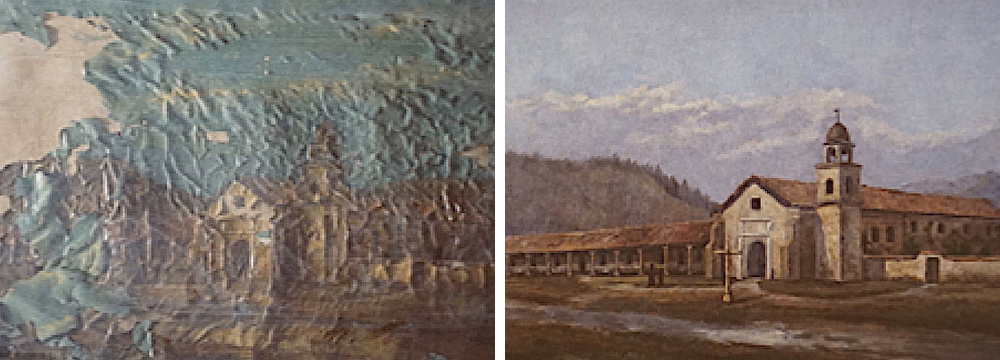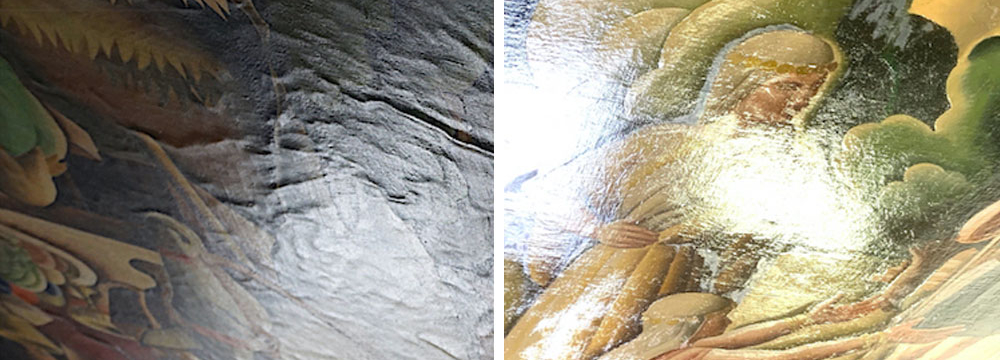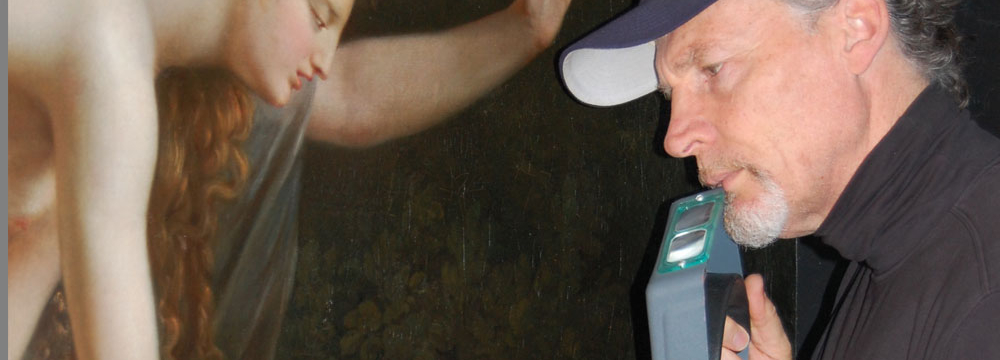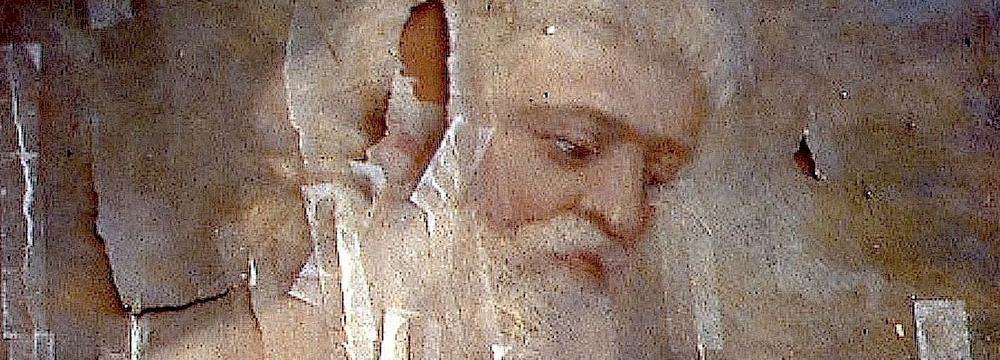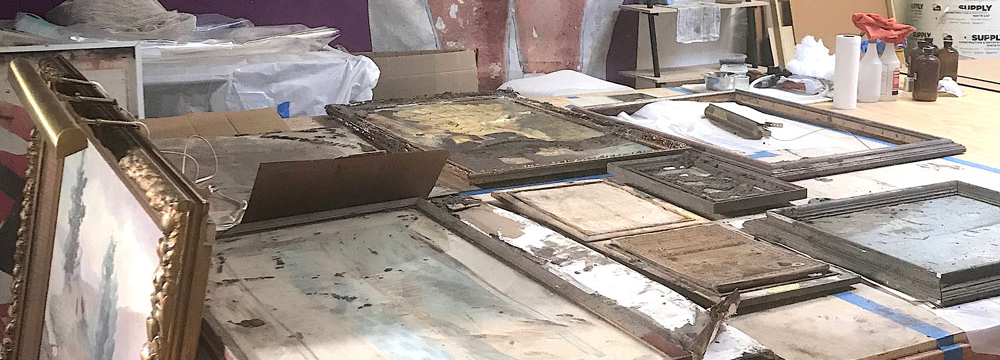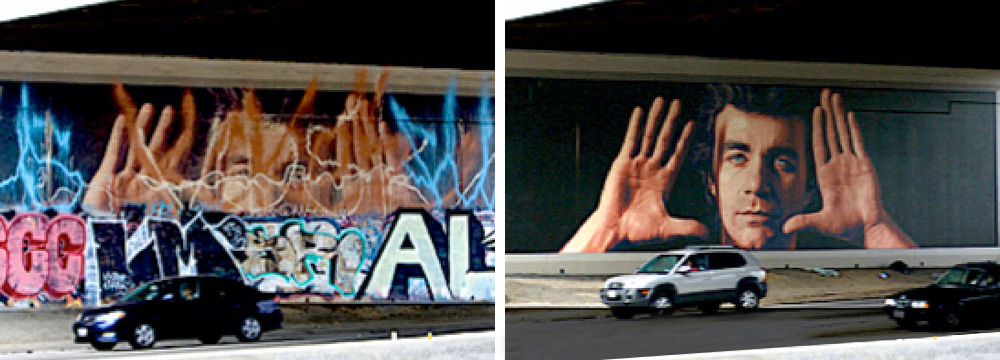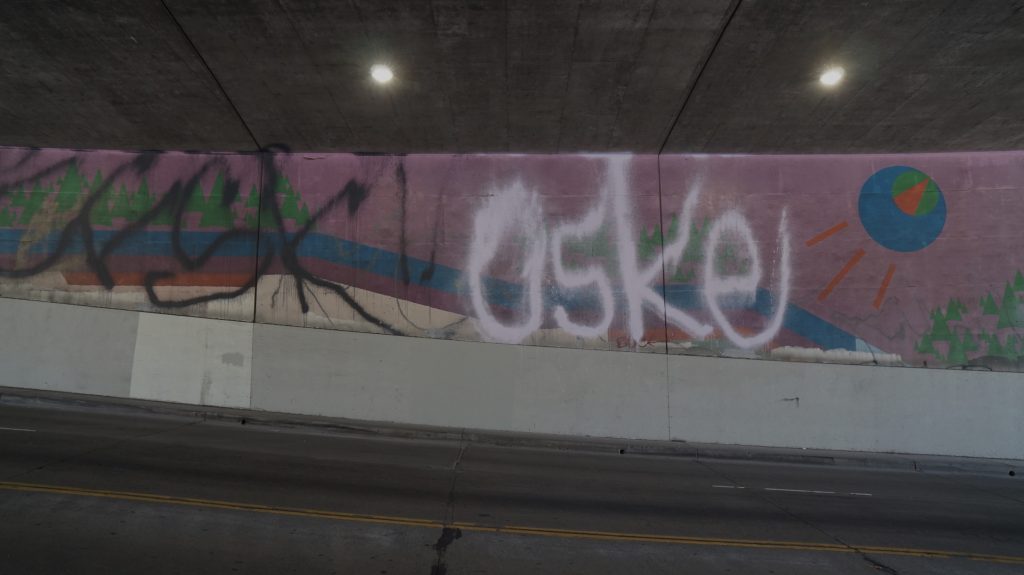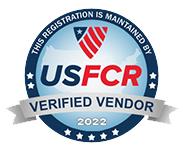This is an anti-graffiti coating utilized by contractors who don’t understand its affect on artwork nor the practical nor the ethical concept of “reversibility” in art conservation.
The information on this page is provided by the manufacturer except for practical application notes (on a mural) provided by this mural conservation lab about half way down this page.
Manufacturer’s contact info: Genesis Coatings 2780 La Mirada Drive, #D Vista, CA 92081 (800) 533-4273
Qualifications:
Skilled contractors, who are trained, experienced, and familiar with two part aliphatic polyurethane coating systems should use product. Contractor must thoroughly read tech spec, label, MSDS and current published application instructions prior to application. If there are any additional technical questions or job requirements, contact Distributor or Manufacturer before commencing.
Preparatory Work:
-Contractor should inspect surface to determine what preparation should be used to achieve the proper profile. Spread rate is dependent on application method, substrate and anticipated level of use. Testing should be completed for accurate figures. Application loss factor is not covered due to surface profile, porosity, surface irregularities, application technique, spillage, film build or climatic conditions.
-All surfaces must be dry and in sound condition. It is necessary to remove all oil, dirt, grease, dust, rust or other contamination to ensure optimal adhesion. Repair all structural defects and fill all voids, marks, protrusions or rough edges to provide a smooth, continuous surface finish.
-Conduct a moisture and pH test prior to applying products.
-Allow all new masonry, concrete construction and repainted surfaces to cure completely before application (a minimum 30 days) with a pH of 10.0 or less.
-A surface masonry conditioner should be applied to brick and other porous surfaces where pH is a concern.
-Retaining or barrier surfaces for earth or flower beds or other such surfaces where moisture vapor transmission is a concern should first be properly sealed and waterproofed, and a moisture test conducted prior to application of the GCP coating.
-Efflorescence can cause product failure in certain bricks if they are not properly cured or conditioned prior to applying the GCP coating.
Compatible Coatings: Can be used over properly prepared metals, epoxies, urethanes and others as recommended.
**It is recommended that a test patch be laid to ensure product compatibility, adhesion, color, resistance and desired finish on the surface. All surfaces should be tested.
Concrete Block: Surfaces should be clean and dry. A filler or sealer may be required to create a more desirable application, reduce outgasing and control pH. Surface temperatures must be at least 50°F. Filler/sealer should be thoroughly dry before applying the coating.
Masonry: Surface temperature must be at least 50°F before painting. All masonry must be free of moisture, oil, dirt, dust, grease, loose paint, mortar and other contaminants. Poured, tilt-up or troweled concrete, plaster, mortar, etc. must be thoroughly cured at least 30 days. Form release compounds, weathered masonry, soft or porous cement board and other curing membranes must be removed by Brush Blasting or Power Tool Cleaning.
Aluminum, Iron & Steel: Surface preparation is Hand Tool Clean per SSPC-SP 2. Remove all oil and grease from surface by Solvent Cleaning per SSPC-SP1 or Commercial Blast Cleaning per SSPC-SP6. Galvanizing: Surface should be exterior weathered for a minimum of six months.
Application Instructions
Painted Surfaces:
Clean previously painted surface of all contaminants. Apply a test area allowing the coating to dry fully before testing adhesion. If adhesion is poor, abrade the area, or if necessary, remove the previous coating. Make sure to apply with all local, state and federal regulations when applying coating over previously painted surfaces.
Application:
Application Methods:
Brush: natural bristle
Roll: 3/8″ or 1⁄4” nap non-shed w/ phenolic core Power Mixer:
Jiffy Mixer powered by air or electric motor Spray: HVLP , Conventional, Plural Component, and Electrostatic. *For proper spray characteristics, changes in pressure and tip size may be needed. Note: This material cannot be sprayed in Florida – it must be rolled or brushed. Manufacturer: Binks, Spray Tech, DeVilbess, Ransberg
Airless spray:
Equipment that has 28:1 or higher pump ratio and a fluid tip with 0.011 to 0.015 – inch (.33 to .38 mm) orifice. Verify.
Conventional spray:
Separate air and fluid pressure regulators, and mechanical pot agitator are recommended. Use adequate air pressure and volume to ensure proper atomization.
*Additional information will require equipment manufacturer’s recommendation.
*Applicator must use precaution when spraying coating. Avoid overspraying and spillage.
*Utilize proper OSHA safety standards when applying in confined areas.
*Do not spray horizontal installations.
Application Conditions:
Temp (air, surface, material): 50°F – 90°F Relative Humidity: 80% maximum
Temperature, high humidity and direct exposure and sunlight can affect the pot life, cure time, dry time, performance and appearance of the coating.
Mixing:
1. Stir Part B (Polyol) for approximately 2 minutes with jiffy blade at slow speed (500 rpm) to fully disperse product. Scrape sides frequently.
2. Pour Part A (Activator) into Part B and mix for 3-4 minutes. Make sure to empty all of the contents from Part A. DO NOT rinse the balance of Part A container into Part B with water. Dwell time required before reduction or application: 5 minutes @ 70-90°F. Loosely cover. Do not reseal mixed product!
3. GCP 1000 must be reduced with clean water. Slowly add 16-22 ounces per 1 unit kit to reach the desired pot life, viscosity and wet edge time of application and to reduce the likelihood of overcoating. For larger kits, contact manufacturer for reduction information. Spray applications require reduction of up to 30-40 seconds in a #2 Zahn cup. Straining is recommended, especially if spraying material.
4. Do not reduce catalyzed product after 30 mins. 5. Important: Mark time to establish pot life. Pot life is 1.5-2 hours depending on humidity and temperature. Discard material after 2.5 hours. Clean equipment with solvents.
6. Product should not be mixed with other products or other containers of GCP 1000. Do not mix partial kits.
GCP 1000
Polyurethane Topcoat
Updated: 10-31-03
Installation:
Smooth Vertical & Horizontal Surfaces: Apply a light coat at a thickness of 3-5 wet mils. Do not exceed 6 wet mils. If using a roller, be sure to back roll any runs or lap marks immediately. Coating sets up quickly and pulls easily.
Porous Surfaces:
Most porous surfaces will require a sealer or filler to adequately eliminate potential pinholes, maintain appearance and control pH prior to applying GCP 1000. Manufacturer recommends applying a test patch to determine appearance and coverage. When applying 2 coats, allow 4 hours between coats or until coating is tack free prior to final application to determine adhesion. Spraying porous surfaces is recommended to reduce the risk of overcoating. Pick up any runs immediately. Apply coating in a crosshatch pattern. One vertical pass and one horizontal pass equals one coat.
IMPORTANT: Proper methods to protect over spraying should be implemented. Atomized particles will adhere to most surfaces and are extremely difficult to remove. Do not allow material to dry onto surface, skin or hair. In all cases, MORE IS NOT BETTER! Heavier applications can result in microblistering, poor adhesion, ambering and/or significant color change. Please contact the manufacturer immediately to address any problems.
Practical Application Notes From A Mural Restoration Project: Important notes during the application of the aliphatic polyurethane coating: the 3 components (2 parts of resin and 1 part water) were mixed as directed with an electric hand drill mixer. Application of the mixture with a roller (low nap) at the supplied concentration was even and “felt” good. It was easy to avoid drips yet could be applied at a satisfactory concentration and “worked” on the surface so as to result in an even resin layer application. When wet, the material has a white milky appearance. When dry, the gloss version is transparent, appears colorless and is very glossy.
Working time for the mixed resin application with a roller on a 70 degree day on a cool wall is 1 ½ hours – 2 hours. At 2 hours, the mixture begins to clot. A single person, applying the resin with a roller can coat a vertical surface of approximately 1,000 – 1,200 sq. ft before the resin begins to set up. This rate held true for multiple people coating a larger surface. Coverage with a spray unit would be different. Read all application directions carefully.
After application, the resin remains tacky for many hours (depending on the RH and ambient temp). By the next day, it is hard.
Contrary to published data, the mixed resin as supplied in the 5 gal bucket (actually about 3 gal of finished, mixed resin in order to leave room for mixing in the bucket) will cover about 3,000 sq. ft of vertical surface. NOTE: if you have left over mixed resin, DO NOT PUT THE LID BACK ON THE BUCKET. It will explode. It will not keep for later. Remember, you have mixed a catalyzed resin. Read all application directions carefully.
Manufacturer’s Notes for Graffiti Removal From This Protective Coating:
1. Spray or brush Graffiti Gold or Graffiti Eaze Away Remover onto vandalized area and allow to stand for 1 to 3 minutes.
2. Agitate with a soft bristle brush or sponge to loosen graffiti from coating.
3. Wipe, spray or hose the cleaned area with water to remove all traces of graffiti.
*Some paints, inks and dyes can be difficult to remove from coated surfaces.
Clean Up:
Clean equipment immediately. Do not allow catalyzed material to stay in hoses beyond pot life. Clean material on skin and hair immediately with industrial soap and water.
Precautions:
Please read Material Safety Data Sheets (MSDS) carefully. Use only with adequate ventilation. Prevent breathing of spray mists. In confined areas, wear a properly fitted respirator during application until all vapor and spray mists are gone. Protect eyes and skin. Do not take internally. Do not use if you have had a prior reaction to polyisocyanate.
NOTE: This material cannot be sprayed in Florida – it must be rolled or brushed.
KEEP OUT OF REACH OF CHILDREN AND ANIMALS!!
Limited Warranty:
The liability of the Manufacturer and/or Distributor to the Buyer or a third party, for any loss or damages, whether direct or otherwise arising out of the purchase of product from Seller by Buyer shall not exceed the total amount billed and billable to the Buyer of the Product hereunder. In no event will Seller and Manufacturer be liable for any loss of profits or other special consequential damages, even if Seller has been advised of the possibility of such damages. The foregoing limitation on liabilities is in lieu of all other warranties expressed or implied including, but not limited to, those concerning merchantability and fitness for a particular purpose.

